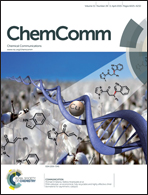Gated supramolecular chemistry in hybrid mesoporous silica nanoarchitectures: controlled delivery and molecular transport in response to chemical, physical and biological stimuli
Abstract
This review presents and discusses recent advances in the emerging field of “gated nanochemistry”, outlining the substantial progress made so far. The development of hybrid mesoporous silica with complex tailored pore nanoarchitectures bridges the gap between molecular materials and the requirements of nanodevices for controlled nanoscale chemistry. In the last decade, membranes, particles and thin film porous architectures have been designed, synthesized and selectively modified by molecular, polymeric, organometallic or biologically active groups. The exquisite manipulation of mesopore morphology and interconnection combined with molecular or supramolecular functionalities, and the intrinsic biological compatibility of silica have made these materials a potential platform for selective sensing and drug delivery. The wide répertoire of these hard–soft architectures permit us to envisage sophisticated intelligent nano-systems that respond to a variety of external stimuli such as pH, redox potential, molecule concentration, temperature, or light. Transduction of these stimuli into a predefined response implies exploiting spatial and physico-chemical effects such as charge distribution, steric constraints, equilibria displacements, or local changes in ionic concentration, just to name a few examples. As expected, this “positional mesochemistry” can be only attained through the concerted control of assembly, surface tailoring and, confinement conditions, thus giving birth to a new class of stimuli-responsive materials with modulable transport properties. As a guiding framework the emerging field of “gated nanochemistry” offers methodologies and tools for building up stimuli-sensitive porous architectures equipped with switchable entities whose transport properties can be triggered at will. The gated nanoscopic hybrid materials discussed here not only herald a new era in the integrative design of “smart” drug delivery systems, but also give the reader a perspective of the promising future in the development of mesoporous platforms that can control mass transport on command through the combination of flexible supramolecular routes, with implications on health, environment and energy.


 Please wait while we load your content...
Please wait while we load your content...